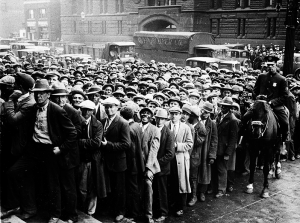Trump says high tariffs may have prevented the Great Depression. History
says different
[April 08, 2025] By
WILL WEISSERT
WASHINGTON (AP) — In the early days of the Great Depression, Rep. Willis
Hawley, a Republican from Oregon, and Utah Republican Sen. Reed Smoot
thought they had landed on a way to protect American farmers and
manufacturers from foreign competition: tariffs.
President Herbert Hoover signed the Smoot-Hawley Tariff Act in 1930,
even as many economists warned that the levies would prompt retaliatory
tariffs from other countries, which is precisely what happened. The U.S.
economy plunged deeper into a devastating financial crisis that it would
not pull out of until World War II.
Most historians look back on Smoot-Hawley as a mistake that made a bad
economic climate much worse. But tariffs have a new champion in
President Donald Trump.
Like Trump, Hoover was elected largely because of his business acumen.
An international mining engineer, financier and humanitarian, he took
office in 1929 like an energetic CEO, eager to promote public-private
partnerships and use the levers of government to promote economic
growth.
“Anyone not only can be rich, but ought to be rich,” he declared in his
inaugural address before convening a special session of Congress to
better protect U.S. farmers with “limited changes of the tariff.”
Instead, the 31st president got the Great Depression.
Trump, now championing his own sweeping tariffs that have sent global
markets into a tailspin, argues that the U.S. was founded on steep
import taxes on goods from abroad.
But the country began abandoning them when it created a federal income
tax in 1913, the president says. Then, "in 1929, it all came to a very
abrupt end with the Great Depression. And it would have never happened
if they had stayed with the tariff policy,” Trump said in announcing his
tariff plan last week.

Referring to Smoot-Hawley, he added, “They tried to bring back tariffs
to save our country, but it was gone. It was gone. It was too late.
Nothing could have been done — took years and years to get out of that
depression.”
America’s history of high tariffs actually continued well after 1913,
however, and Trump’s take on what sparked the Great Depression — and
Hoover-era Washington's response to it — don't reflect what actually
happened.
Gary Richardson, an economics professor at the University of California,
Irvine, said the U.S. long maintaining high tariffs “helped to shift
industry here. But we’ve gotten rid of them because, as the country at
the cutting edge of technology, we didn’t think they were useful.”
“When we were at our most powerful, right after World War II, we forced
a low tariff regime on most of the world because we thought it was to
our benefit," said Richardson, also a former Federal Reserve System
historian. "Now, we’re going back to something else.”
Tariffs date to 1789
George Washington signed the Tariff Act of 1789, the first major
legislation approved by Congress, which imposed a 5% tax on many goods
imported into the U.S. With no federal income tax, the policy was about
finding sources of revenue for the government while also protecting
American producers from foreign competition.
After the War of 1812 disrupted U.S. trade with Great Britain, the U.S.
approved more tariffs in 1817 meant to shield domestic manufacturing
from potentially cheaper imports, especially textiles.
High tariffs remained for decades, particularly as the government looked
to increase its revenue and pay down debt incurred during the Civil War.
The Tariff Act of 1890 raised taxes to 49.5% on 1,500-plus items.
Championing the move was the “Napoleon of Protectionism,” William
McKinley, an Ohio Republican congressman who would be elected president
in 1896 and one of Trump's heroes.
But that move caused prices to rise and the U.S. economy to fall. It
worsened after the Panic of 1893, when unemployment reached 25%.
Historians referred to the period as the “great depression” until it was
superseded by the actual Great Depression.

An income tax replaces tariffs
A national income tax didn't become permanent until Congress passed the
16th Amendment in 1909, and it was ratified four years later. Despite
what Trump suggests, what followed was continued economic growth —
fueled by technological advances like the telephone and increased
consumer spending after World War I.
A construction boom, and increased manufacturing output — particularly
for consumer goods that included the automobile — helped spark the
“Roaring 20s." The Dow Jones Industrial Average increased six-fold —
climbing from 63 points in August of 1921 to nearly 400 in September of
1929.
It was the Prohibition era and the jazz age, a period of urbanization
even as farming remained a key economic driver. Working conditions were
often poor, but the standard of living climbed for the middle class,
which enjoyed innovations like broadcast radio and washing machines.
High tariff policy also persisted, with Congress approving the
Fordney-McCumber Act of 1922, which raised levies to their highest in
U.S. history on many imported goods in an effort to further bolster
domestic manufacturing. That prompted retaliatory tariffs from key U.S.
trading partners — mirroring the reactions of contemporary China and
other countries to Trump’s new levies.
[to top of second column] |

Thousands of unemployed people gather outside City Hall in Cleveland
during the Great Depression, after some 2,000 jobs were made
available for park improvements and repairs, Oct. 9, 1930. (AP
Photo, File)
 ‘Black Tuesday’ and The Great
Depression
The economy began slowing when the Fed raised interest rates in 1928
and the following year.
The idea was mostly to ease a stock market bubble by reducing
lending to brokers or firms buying stocks. But that triggered higher
interest rates in Britain and Germany, which helped slow global
consumer spending and production, and began a U.S. recession in the
summer of 1929.
The Great Depression began with “Black Tuesday” on Oct. 29, 1929,
when a panic selloff triggered a stock market collapse, wiping out
thousands of investors who had borrowed heavily. As consumer demand
declined, manufacturing firms laid off workers and idled factories.
In subsequent years, the U.S. unemployment rate reached 25%, while
economic output plunged nearly 30%. There were thousands of bank
failures and widespread business closures, while millions of
Americans lost their homes.
Smoot-Hawley
With self-made wealth and global sympathies, Hoover cut a very
different figure than Trump.
Hoover was orphaned at 9 and led World War I-humanitarian food
relief efforts while living in London. He also served as commerce
secretary before running for president. He could be dynamic with
small groups but reserved in public.
“There’s no theater to Herbert Hoover," said David Hamilton, a
history professor at the University of Kentucky.
Trying to keep his campaign promise to protect farmers, Hoover
pushed Congress for higher agricultural tariffs. But a chief goal
was encouraging farmers to produce new types of crops, and Hoover
didn't view steeper U.S. tariffs as incompatible with global trade,
Hamilton said.
“He’s not weaponizing trade in the way we see today,” said Hamilton,
author of “From New Day to New Deal: American Farm Policy from
Hoover to Roosevelt, 1928-1933."
Hawley, chairman of the House Ways and Means Committee, originally
sought farming protections. But the finished bill went much farther,
using high tariffs to protect manufacturing. It passed the House in
May 1929.

Smoot, who chaired the Senate finance committee, helped oversee
passage there in March 1930. Reconciled legislation that became the
Smoot-Hawley Tariff Act finally cleared Congress that June.
Hoover was conflicted, especially after more than 1,000 U.S.
economists signed a letter urging a veto. But he signed the act,
saying in a statement, “No tariff bill has ever been enacted, or
ever will be enacted, under the present system that will be
perfect.”
That's all a departure from another businessman-turned-president,
Trump, who grew up wealthy and was a real estate mogul and reality
TV star who had never served in government before first winning the
presidency in 2016.
Trump has long championed tariffs as a way to protect the U.S.
economy and manufacturing at the expense of its global trading
partners. And he bypassed Congress potentially modifying the scope
of his policy aims by declaring an “economic emergency” to institute
tariffs unilaterally.
Smoot-Hawley raised import tariffs by an average of 20% on thousands
of goods, causing many top U.S. trading partners to retaliate.
International cooperation on non-trade issues also declined,
including on defense matters, helping clear the way for the rise of
Hitler, Richardson said.
“There were some industries where they made profits,” Richardson
said of Smoot-Hawley. “But overall, people in the U.S. and people
around the world were losers.”
U.S. manufacturers saw foreign markets for their goods evaporate and
output and consumer spending sank still further. Hawley lost the
1932 Oregon Republican primary in his district, and Smoot was
defeated in November, as Democrat Franklin D. Roosevelt trounced
Hoover for the presidency.
Smoot, Hawley and Hoover largely kept defending their tariff
policies in subsequent years, blaming international trade policies
and external monetary forces — as well as Democrats — for America's
economic woes. The economy wouldn’t begin its recovery until the
outbreak of World War II increased demand for factory production in
1939.
“Economic depression cannot be cured by legislative action or
executive pronouncement,” Hoover said in December 1930. "Economic
wounds must be healed by the action of the cells of the economic
body -- the producers and consumers themselves.
All contents © copyright 2025 Associated Press. All rights reserved
 |